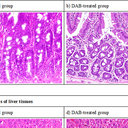Extraction of antioxidant components from Bidens pilosa flowers and their uptake by human intestinal Caco-2 cells.
Ключавыя словы
Рэферат
Bidens pilosa L. var. radiata (BPR, Asteraceae) is a commonly used folk medicine for treating various disorders such as diabetes, inflammation and hypertension. Recent studies to determine its chemical composition have revealed three di-O-caffeoylquinic acids (DiCQAs) and three polyacetylene glucosides (PGAs) to be among the major bioactive markers. To obtain the major compounds of these two chemical classes, the ethyl acetate fraction (EM) obtained using liquid-liquid partition from the methanol extract resulted in a fraction with the highest total phenolic and total flavonoid contents and antioxidant activities in radical scavenging and ferric reducing power assays. To assess the bioavailability of EM, we examined the in vitro uptake using the Caco-2 human colonic cell line. The apparent permeability coefficient (Papp) for each of the compounds within PGAs measured in both apical (AP) to basolateral (BL) and BL to AP was found to preferentially appear BL to AP direction, indicated that a basolateral to apical efflux system was detected in the study. DiCQAs had a lower efflux ratio than those from PGAs (2.32-3.67 vs. 6.03-78.36). Thus, it strongly implies that most of the DiCQAs are better absorbed than the PGAs.


